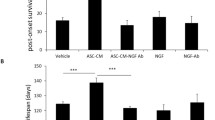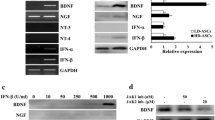Abstract
Oxidative stress is a common feature in neurodegenerative diseases associated with neuroinflammation, and therefore, has been proposed as a key target for novel therapies for these diseases. Recently, adipose-derived stem cell (ASC)-based cell therapy has emerged as a novel strategy for neuroprotection. In this study, we evaluate the therapeutic role of ASC-conditioned medium (ASC-CM) against H2O2-induced neurotoxicity in a new in vitro model of ec23/brain-derived neurotrophic factor (BDNF)-differentiated human SH-SY5Y neuron-like cells (SH-SY5Yd). In the presence of ASC-CM, stressed SH-SY5Yd cells recover normal axonal morphology (with an almost complete absence of H2O2-induced axonal beading), electrophysiological features, and cell viability. This beneficial effect of ASC-CM was associated with its antioxidant capacity and the presence of growth factors, namely, BDNF, glial cell line-derived neurotrophic factor, and transforming growth factor β1. Moreover, the neuroprotective effect of ASC-CM was very similar to that obtained from treatment with BDNF, an essential factor for SH-SY5Yd cell survival. Importantly, we also found that the addition of the antioxidant agent N-acetyl cysteine to ASC-CM abolished its restorative effect; this was associated with a strong reduction in reactive oxygen species (ROS), in contrast to the moderate decrease in ROS produced by ASC-CM alone. These results suggest that neuronal restorative effect of ASC-CM is associated with not only the release of essential neurotrophic factors, but also the maintenance of an appropriate redox state to preserve neuronal function.





Similar content being viewed by others
References
Cobb CA, Cole MP (2015) Oxidative and nitrative stress in neurodegeneration. Neurobiol Dis 84:4–21
Leszek J, Barreto GE, Gąsiorowski K, Koutsouraki E, Ávila-Rodrigues M, Aliev G (2016) Inflammatory mechanisms and oxidative stress as key factors responsible for progression of neurodegeneration: role of brain innate immune system. CNS Neurol Disord Drug Targets 15:329–336
Li J, O W, Li W, Jiang ZG, Ghanbari HA (2013) Oxidative stress and neurodegenerative disorders. Int J Mol Sci 14:24438–24475
Wang JY, Wen LL, Huang YN, Chen YT, Ku MC (2006) Dual effects of antioxidants in neurodegeneration: direct neuroprotection against oxidative stress and indirect protection via suppression of glia-mediated inflammation. Curr Pharm Des 12:3521–3533
Chiurchiù V, Orlacchio A, Maccarrone M (2016) Is modulation of oxidative stress an answer? The state of the art of redox therapeutic actions in neurodegenerative diseases. Oxid Med Cell Longev 2016:7909380
Deepmala D, Slattery J, Kumar N, Delhey L, Berk M, Dean O, Spielholz C, Frye R (2015) Clinical trials of N-acetylcysteine in psychiatry and neurology: a systematic review. Neurosci Biobehav Rev 55:294–321
Rege SD, Geetha T, Broderick TL, Babu JR (2015) Resveratrol protects β amyloid-induced oxidative damage and memory associated proteins in H19-7 hippocampal neuronal cells. Curr Alzheimer Res 12:147–156
Gaspar A, Milhazes N, Santana L, Uriarte E, Borges F, Matos MJ (2015) Oxidative stress and neurodegenerative diseases: looking for a therapeutic solution inspired on benzopyran chemistry. Curr Top Med Chem 15:432–445
Wang Q, Chuikov S, Taitano S et al (2015) Dimethyl fumarate protects neural stem/progenitor cells and neurons from oxidative damage through Nrf2-ERK1/2 MAPK pathway. Int J Mol Sci 16:13885–13907
Tanna T, Sachan V (2014) Mesenchymal stem cells: potential in treatment of neurodegenerative diseases. Curr Stem Cell Res Ther 9:513–521
Bonafede R, Scambi I, Peroni D, Potrich V, Boschi F, Benati D, Bonetti B, Mariotti R (2016) Exosome derived from murine adipose-derived stromal cells: Neuroprotective effect on in vitro model of amyotrophic lateral sclerosis. Exp Cell Res 340:150–158
Teixeira FG, Carvalho MM, Panchalingam KM, Rodrigues AJ, Mendes-Pinheiro B, Anjo S, Manadas B, Behie LA et al (2016) Impact of the secretome of human mesenchymal stem cells on brain structure and animal behavior in a rat model of Parkinson’s disease. Stem Cells Transl Med. doi:10.5966/sctm.2016-0071
Zhang HT, Liu ZL, Yao XQ, Yang ZJ, Xu RX (2012) Neural differentiation ability of mesenchymal stromal cells from bone marrow and adipose tissue: a comparative study. Cytotherapy 14:1203–1214
Konno M, Hamabe A, Hasegawa S, Ogawa H, Fukusumi T, Nishikawa S, Ohta K, Kano Y et al (2013) Adipose-derived mesenchymal stem cells and regenerative medicine. Develop Growth Differ 55:309–318
Parimisetty A, Dorsemans AC, Awada R, Ravanan P, Diotel N, Lefebvre d'Hellencourt C (2016) Secret talk between adipose tissue and central nervous system via secreted factors-an emerging frontier in the neurodegenerative research. J Neuroinflammation 13:67
Wan Z, Mah D, Simtchouk S, Kluftinger A, Little JP (2015) Human adipose tissue conditioned media from lean subjects is protective against H2O2 induced neurotoxicity in human SH-SY5Y neuronal cells. Int J Mol Sci 16:1221–1231
Liu W, Lang M, Youdim MB, Amit T, Sun Y, Zhang Z, Wang Y, Weinreb O (2016) Design, synthesis and evaluation of novel dual monoamine-cholinesterase inhibitors as potential treatment for Alzheimer’s disease. Neuropharmacology 109:376–385
Ramalingam M, Kim SJ (2016) The neuroprotective role of insulin against MPP(+)-induced Parkinson’s disease in differentiated SH-SY5Y cells. J Cell Biochem 117:917–926
Encinas M, Iglesias M, Liu Y, Wang H, Muhaisen A, Ceña V, Gallego C, Comella JX (2000) Sequential treatment of SH-SY5Y cells with retinoic acid and brain-derived neurotrophic factor gives rise to fully differentiated, neurotrophic factor-dependent, human neuron-like cells. J Neurochem 75:991–1003
Goldie BJ, Barnett MM, Cairns MJ (2014) BDNF and the maturation of posttranscriptional regulatory networks in human SH-SY5Y neuroblast differentiation. Front Cell Neurosci 8:325
Suzuki T, Kunchala SR, Matsui M, Murayama A (1998) Molecular flexibility of retinoic acid under white fluorescent light. J Nutr Sci Vitaminol 44:729–736
Clemens G, Flower KR, Henderson AP, Whiting A, Przyborski SA, Jimenez-Hernandez M, Ball F, Bassan P et al (2013) The action of all-trans-retinoic acid (ATRA) and synthetic retinoid analogues (EC19 and EC23) on human pluripotent stem cells differentiation investigated using single cell infrared microspectroscopy. Mol BioSyst 9:677–692
Christie VB, Maltman DJ, Henderson AP, Whiting A, Marder TB, Lako M, Przyborski SA (2010) Retinoid supplementation of differentiating human neural progenitors and embryonic stem cells leads to enhanced neurogenesis in vitro. J Neurosci Methods 193:239–245
Castaño J, Menendez P, Bruzos-Cidon C, Straccia M, Sousa A, Zabaleta L, Vazquez N, Zubiarrain A et al (2014) Fast and efficient neural conversion of human hematopoietic cells. Stem Cell Rep 3:1118–1131
Barreto GE, Gonzalez J, Capani F, Morales L (2012) Neuroprotective agents in brain injury: a partial failure? Int J Neurosci 122(5):223–226
Spagnuolo C, Napolitano M, Tedesco I, Moccia S, Milito A, Russo GL (2016) Neuroprotective role of natural polyphenols. Curr Top Med Chem 16:1943–11950
Carvalho AN, Firuzi O, Gama MJ, van Horssen J, Saso L (2016) Oxidative stress and antioxidants in neurological diseases: is there still hope? Curr Drug Targets 17. doi:10.2174/1389450117666160401120514
Choonara YE, Kumar P, Modi G, Pillay V (2016) Improving drug delivery technology for treating neurodegenerative diseases. Expert Opin Drug Deliv 13:1029–1043
Kim Y, Jo SH, Kim WH, Kweon OK (2015) Antioxidant and anti-inflammatory effects of intravenously injected adipose derived mesenchymal stem cells in dogs with acute spinal cord injury. Stem Cell Res Ther 6:229
Kovalevich J, Langford D (2013) Considerations for the use of SH-SY5Y neuroblastoma cells in neurobiology. Methods Mol Biol 1078:9–21
Imlay JA (2008) Cellular defenses against superoxide and hydrogen peroxide. Annu Rev Biochem 77:755–776
Ramalingam M, Kim SJ (2014) The role of insulin against hydrogen peroxide-induced oxidative damages in differentiated SH-SY5Y cells. J Recept Signal Transduct Res 34(3):212–220
Fang C, Bourdette D, Banker G (2012) Oxidative stress inhibits axonal transport: implications for neurodegenerative diseases. Mol Neurodegener 7:–29
Wang H, Kunkel DD, Martin TM, Schwartzkroin PA, Tempel BL (1993) Heteromultimeric K+ channels in terminal and juxtaparanodal regions of neurons. Nature 365:75–79
Tosetti P, Taglietti V, Toselli M (1998) Functional changes in potassium conductances of the human neuroblastoma cell line SH-SY5Y during in vitro differentiation. J Neurophysiol 79:648–658
Radak Z, Zhao Z, Goto S, Koltai E (2011) Age-associated neurodegeneration and oxidative damage to lipids, proteins and DNA. Mol Asp Med 32:305–315
Fukui K, Takatsu H, Koike T, Urano S (2011) Hydrogen peroxide induces neurite degeneration: Prevention by tocotrienols. Free Radic Res 45:681–691
Kim WS, Park BS, Kim HK, Park JS, Kim KJ, Choi JS, Chung SJ, Kim DD et al (2008) Evidence supporting antioxidant action of adipose-derived stem cells: protection of human dermal fibroblasts from oxidative stress. J Dermatol Sci 49:133–142
Liang CM, Weng SJ, Tsai TH, Li IH, Lu PH, Ma KH, Tai MC, Chen JT et al (2014) Neurotrophic and neuroprotective potential of human limbus-derived mesenchymal stromal cells. Cytotherapy 16:1371–1383
Hachem LD, Mothe AJ, Tator CH (2015) Effect of BDNF and other potential survival factors in models of in vitro oxidative stress on adult spinal cord-derived neural stem/progenitor cells. Biores Open Access 4:146–159
Ribeiro CA, Salgado AJ, Fraga JS, Silva NA, Reis RL, Sousa N (2011) The secretome of bone marrow mesenchymal stem cells—conditioned media varies with time and drives a distinct effect on mature neurons and glial cells (primary cultures). J Tissue Eng Regen Med 5:668–672
Cova L, Armentero MT, Zennaro E, Calzarossa C, Bossolasco P, Busca G, Lambertenghi Deliliers G, Polli E et al (2010) Multiple neurogenic and neurorescue effects of human mesenchymal stem cell after transplantation in an experimental model of Parkinson’s disease. Brain Res 1311:12–27
Mctigue DM, Popovich PG, Morgan TE, Stokes BT (2000) Localization of transforming growth factor-beta1 and receptor mRNA after experimental spinal cord injury. Exp Neurol 163:220–230
Salgado AJ, Sousa JC, Costa BM, Pires AO, Mateus-Pinheiro A, Teixeira FG, Pinto L, Sousa N (2015) Mesenchymal stem cells secretome as a modulator of the neurogenic niche: basic insights and therapeutic opportunities. Front Cell Neurosci 9:–249
Pandya JD, Readnower RD, Patel SP, Yonutas HM, Pauly JR, Goldstein GA, Rabchevsky AG, Sullivan PG (2014) N-acetylcysteine amide confers neuroprotection, improves bioenergetics and behavioral outcome following TBI. Exp Neurol 257:106–113
Rushworth GF, Megson IL (2014) Existing and potential therapeutic uses for N-acetylcysteine: the need for conversion to intracellular glutathione for antioxidant benefits. Pharmacol Ther 141:150–159
Adair JC, Knoefel JE, Morgan N (2001) Controlled trial of N-acetylcysteine for patients with probable Alzheimer’s disease. Neurology 57:1515–1517
Wang Q, Zhu H, Zhou WG, Guo XC, Wu MJ, Xu ZY, Jiang JF, Shen C et al (2013) N-acetylcysteine-pretreated human embryonic mesenchymal stem cell administration protects against bleomycin-induced lung injury. Am J Med Sci 346:113–122
Moriyama M, Moriyama H, Ueda A, Nishibata Y, Okura H, Ichinose A, Matsuyama A, Hayakawa T (2012) Human adipose tissue-derived multilineage progenitor cells exposed to oxidative stress induce neurite outgrowth in PC12 cells through p38 MAPK signaling. BMC Cell Biol 13:21
Ristow M, Schmeisser K (2014) Mitohormesis: promoting health and lifespan by increased levels of reactive oxygen species (ROS). Dose Response 12:288–341
Valko M, Leibfritz D, Moncol J, Cronin MT, Mazur M, Telser J (2007) Free radicals and antioxidants in normal physiological functions and human disease. Int J Biochem Cell Biol 39:44–84
Conti V, Izzo V, Corbi G, Russomanno G, Manzo V, De Lise F, Di Donato A, Filippelli A (2016) Antioxidant supplementation in the treatment of aging-associated diseases. Front Pharmacol 7:24
Xiong W, MacColl Garfinkel AE, Li Y, Benowitz LI, Cepko CL (2015) NRF2 promotes neuronal survival in neurodegeneration and acute nerve damage. J Clin Invest 125:1433–1445
Prasad KN (2016) Simultaneous activation of Nrf2 and elevation of antioxidant compounds for reducing oxidative stress and chronic inflammation in human Alzheimer’s disease. Mech Ageing Dev 153:41–47
Zhang G, Zou X, Huang Y, Wang F, Miao S, Liu G, Chen M, Zhu Y (2016) Mesenchymal stromal cell-derived extracellular vesicles protect against acute kidney injury through anti-oxidation by enhancing Nrf2/ARE activation in rats. Kidney Blood Press Res 41:119–128
Acknowledgments
This work has been partially supported by grants from the University of the Basque Country (reference GIU/16), the Basque Government (reference IT747-13), and the Jesus Gangoiti Barrera Foundation. We would like to acknowledge General Research Services from the University of the Basque Country (SGIker, UPV/EHU) for their technical support.
Author Contribution Summary
Teodoro Palomares and María Cordero contributed equally to this paper.
Author information
Authors and Affiliations
Corresponding author
Ethics declarations
Conflict of Interest
The authors confirm that they have no conflicts of interest.
Rights and permissions
About this article
Cite this article
Palomares, T., Cordero, M., Bruzos-Cidon, C. et al. The Neuroprotective Effect of Conditioned Medium from Human Adipose-Derived Mesenchymal Stem Cells is Impaired by N-acetyl Cysteine Supplementation. Mol Neurobiol 55, 13–25 (2018). https://doi.org/10.1007/s12035-017-0714-0
Published:
Issue Date:
DOI: https://doi.org/10.1007/s12035-017-0714-0




